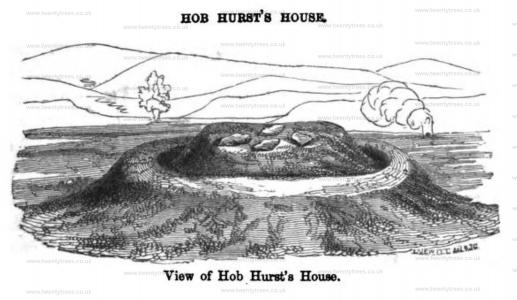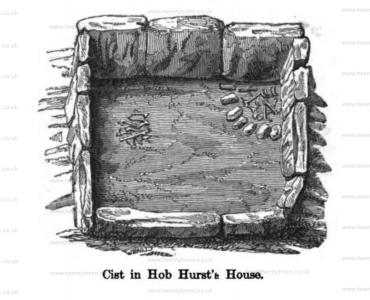Ten Years' Digging 1853
Ten Years' Digging 1853 is in Ten Years' Digging.
On the 10th of April, we examined a mound [Bank Top Barrow [Map]] situated in a small waterless valley near the farm-house at Bank Top, near Hartington, but found that although it had evidently been cast up as a barrow, its contents had been removed at a former period, as we discovered traces of recent excavation in the presence of pieces of earthenware, such as was used in the last century, dispersed throughout the centre. The tumulus was composed of earth and stones, heaped up on the surface of the land to the height of three feet at least. We observed numerous pieces of animal bone, part of a stag's horn, and a few pieces of Romano-British pottery about the natural surface; one of the latter is the circular bottom of a vessel about three inches diameter, which appears to have had the broken edge rubbed down previous to its being buried.
Books, Prehistory, Ten Years' Digging 1853 Hob Hurst's House ![]()
On the 3rd of June, we went to a conspicuous mound on the heathery uninclosed, and most elevated part of Baslow Moor, called Hob Hurst's House [Map], and found it to be a circular tumulus, composed of sand and gritstones, about eleven yards diameter, and four feet high; though, from its being surrounded by an embankment, inside of which the earth had been cut in the form of a ditch, the height appeared fully six feet, and it was only by digging down to the natural surface, that we were able to ascertain the actual elevation. The diameter at the outside of the embankment waa 22 yards, it was formed, like the mound, of stones and sand, and was fourteen feet thick at the base and about four feet high. A trench cut from the south side of the central mound, disclosed some large upright slabs of gritstone, set on the natural level, which we at once perceived to be part of a cist or sepulchral chamber, which was soon cleared out and sketched.
It was rectangular, measuring from north to south ten feet three inches, and nine feet from east to west, and was chiefly constructed of slabs of stone each nearly a yard broad. There were traces of fire throughout the whole enclosure; the undisturbed sand having been burnt to a dirty white, or cream colour, and covered with a layer of charcoal, which was thickest towards the east side, where in the comer formed by the junction of the south boundary of the chamber, we discovered the original deposit, consisting of calcined human bones, lying in the very spot where they had been drawn together while the embers of the funeral pyre were glowing. They were in a small heap along with some thick pieces of charcoal and two lumps of burnt lead ore; and were separated or marked oiF from the floor of the chamber by a semicircular row of small sandstone boulders, all of which exhibited marks of fire. A few more burnt bones were found embedded in the sand near the north end of the cist, but no instrument or pottery of any kind was seen, although one of the pieces of charred wood exhibits a cleanly cut oblique surface, which must have been effected by a sharp instrument. The popular name given to the barrow, we have an indirect testimony to its great antiquity, as Hobhurst's House signifies the abode of an unearthly or supernatural being, accustomed to haunt woods and other solitary places, respecting whom many traditions yet linger in remote-villages. Such an idea could only arise in a superstitious age long ago, yet sufficiently modem to have effaced all traditionary recollection of the original intention of the mound; it likewise affords a curious instance of the inherent tendency of the mind to assign a reason for everything uncommon or unaccountable, which no extent of ignorance or apathy seems able totally to eradicate.
Many of the remaining pre-historic monuments of our land are similarly connected with names well know in popular mythology, now so rapidly vanishing, that it is probable the legends will be forgotten, while the names alone will be perpetuated as long as the structures with which they are identified exist. We may here observe, that the practice of separating the deposits within the cist by pebbles, as in this barrow, is most unusual in the Midland Counties, but is described as prevalent in the Channel Islands, by Mr. Lukis, in the Journal of the British Archaeological Institute, Vol I., page 142.


On the 22nd of September, we opened a barrow near King Sterndale, called High Low [Map], which being situated in a rough plantation, was incapable of measurement; it did not appear, however, to have been very large even at first, and had evidently been reduced in size since. We excavated a good deal of the centre, which we found about three feet higher than the natural surface, upon which was a considerable quantity of charcoal, but found that the whole had been turned over and plundered, so that nothing but fragments were seen. From them it was clear that two interments had taken place in the mound, the traces of the most ancient being manifest in part of a large coarse urn, a calcined flint, and probably the charcoal; those of the more recent were the bones of an adult skeleton, which had been accompanied by a drinking-cup, and many broken bones of animals, including stags' horns, some of the latter having been tooled or sawed. Bones of the water rat were plentifully distributed amongst the stones in the more open part of the tumulus.
Another mound, in a field close by, had been so thoroughly destroyed that we did not think it worth the trouble of examination.